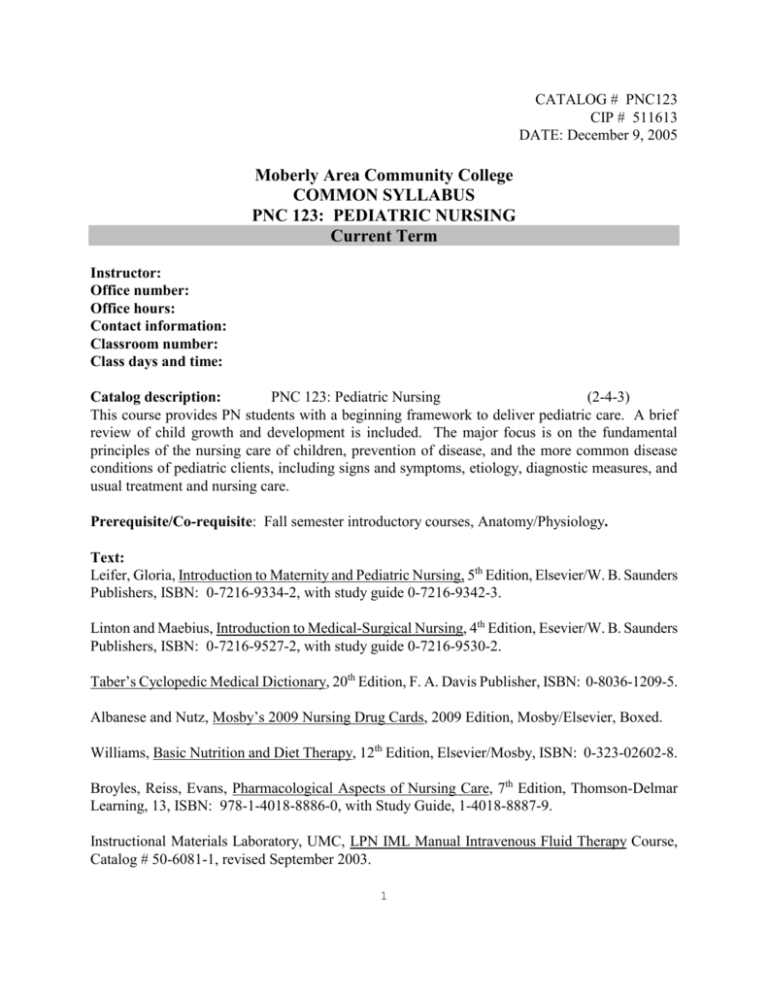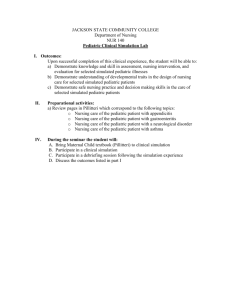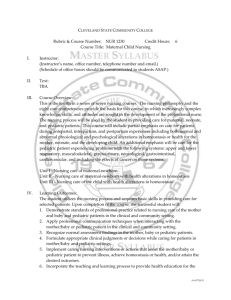
CATALOG # PNC123
CIP # 511613
DATE: December 9, 2005
Moberly Area Community College
COMMON SYLLABUS
PNC 123: PEDIATRIC NURSING
Current Term
Instructor:
Office number:
Office hours:
Contact information:
Classroom number:
Class days and time:
Catalog description:
PNC 123: Pediatric Nursing
(2-4-3)
This course provides PN students with a beginning framework to deliver pediatric care. A brief
review of child growth and development is included. The major focus is on the fundamental
principles of the nursing care of children, prevention of disease, and the more common disease
conditions of pediatric clients, including signs and symptoms, etiology, diagnostic measures, and
usual treatment and nursing care.
Prerequisite/Co-requisite: Fall semester introductory courses, Anatomy/Physiology.
Text:
Leifer, Gloria, Introduction to Maternity and Pediatric Nursing, 5th Edition, Elsevier/W. B. Saunders
Publishers, ISBN: 0-7216-9334-2, with study guide 0-7216-9342-3.
Linton and Maebius, Introduction to Medical-Surgical Nursing, 4th Edition, Esevier/W. B. Saunders
Publishers, ISBN: 0-7216-9527-2, with study guide 0-7216-9530-2.
Taber’s Cyclopedic Medical Dictionary, 20th Edition, F. A. Davis Publisher, ISBN: 0-8036-1209-5.
Albanese and Nutz, Mosby’s 2009 Nursing Drug Cards, 2009 Edition, Mosby/Elsevier, Boxed.
Williams, Basic Nutrition and Diet Therapy, 12th Edition, Elsevier/Mosby, ISBN: 0-323-02602-8.
Broyles, Reiss, Evans, Pharmacological Aspects of Nursing Care, 7th Edition, Thomson-Delmar
Learning, 13, ISBN: 978-1-4018-8886-0, with Study Guide, 1-4018-8887-9.
Instructional Materials Laboratory, UMC, LPN IML Manual Intravenous Fluid Therapy Course,
Catalog # 50-6081-1, revised September 2003.
1
Lefever-Kee, Laboratory and Diagnostic Tests with Nursing Implications, 7th Edition,
Pearson/Prentice Hall, ISBN: 0-13-118267-6.
Ladwig and Ackley, Mosby’s Guide to Nursing Diagnosis, 2nd Edition, Mosby/Elsevier, ISBN: 0323-03665-1.
MACC, Pediatrics PowerPoint-PN, MACC Publisher, ISBN: Unknown.
Other required Materials/ Facilities:
MACC Moberly and Mexico Skills lab, PowerPoint and computerized instructional device,
lectures, guest lecturers, videos, training aides, and transparencies, skills lab, stethoscope, watch with
second hand, bandage scissors, hemostat, penlight, and skills check-off list.
Purpose of course: This course is designed to provide a beginning level competence for the
Practical Nursing student in pediatric care. A brief review of child growth and development is
included. The major focus is on the fundamental principles of the nursing care of children and the
prevention of disease. Study includes common childhood diseases of the pediatric client with
emphasis on signs and symptoms, etiology, diagnostic measures, and usual treatment and nursing
care. Clinical experience is provided at Moberly Regional Medical Center and Audrain Medical
Center.
Course Objectives:
After completion of this course, the student should be able to:
1.
2.
3.
4.
5.
6.
7.
8.
9.
10.
Trace the process of normal growth and development and relate how this process is altered
by illness for the pediatric client.
Identify public and private agencies concerned with child health and illness, describe their
specific functions and how the nurse can make use of these agencies to help the Pediatric
client and his/her family.
Identify various methods of communication as they relate to various age groups and cultural
influences.
Identify methods of developing therapeutic interpersonal relationship with various age
groups as well as their primary caregivers.
Identify the leadership expectations for the Practical Nurse providing care for Pediatric
clients and their families.
Assess the psychological and physical needs of the Pediatric client from birth to adolescence
and adapt the needs of the well child to the care of the sick child.
Assess the psychological effects of illness and hospitalization on the child and his/her family.
Identify the function of the practical nurse in administering nursing care, evaluating
diagnostic tests, and in promoting a therapeutic nurse-child and nurse-family relationship.
Identify the more commonly occurring illnesses and abnormalities of the child at each age
level, their signs and symptoms, etiology, treatment, and nursing care.
Identify the complications, fluids, etc. in IV therapy related to this age group compared to
adult clients.
2
11.
12.
13.
14.
Identify cultural considerations for each age group of the pediatric client.
Describe the concept of culture related to the pediatric client.
Discuss components of culture, patient to nursing care for the pediatric client.
Describe ways to overcome cultural barriers to health care for the pediatric client.
Clinical Objectives: Pediatrics
1.
Observe and practice appropriate verbal and non-verbal communication skills with the
pediatric patient and their families.
2.
Observe the child's reaction to hospitalization and assist in meeting their physical and
emotional needs.
3.
Select diversional activities appropriate to the child's age level.
4.
Recognize and preserve the individuality of each child cared for.
5.
Recognize the difference in the philosophy of pediatric and adult care.
6.
Develop observational skills; report, recognize, and chart accurately and concisely pertinent
symptoms and reactions to their environment.
7.
Observe interaction between child and parents and assist in providing a therapeutic teaching
role.
8.
Practice safety measures and adapt nursing skills to meet the needs of the hospitalized child
considering age, sex, socioeconomic and religious background.
9.
Identify the role of the LPN in a hospital clinic/office setting, day care and Arthur Center
setting.
10.
Identify and use the appropriate equipment specific to pediatrics.
11.
Demonstrate basic nursing skills for pediatric patients including vital signs, weight, physical
assessment, personal care, documentation, hygienic care, and special nursing procedures
related to the pediatric patient.
12.
Implement appropriate nursing measures in selected problems encountered in the clinical
area related to the care of the assigned pediatric patient.
13.
Recognize the importance of the pediatric patient’s family to the pediatric recovery.
14.
Write a plan of care for the pediatric patient selected by the instructor.
15.
Implement physical comfort for the pediatric patient.
16.
Gain understanding in the use of additional health care resources and referrals.
Course Content:
Text: Leifer, Gloria Introduction to Maternity and Pediatric Nursing
1.
The Past, the Present, and the Future of Maternity and Pediatric Nursing
A.
Introduction
B.
The Past
C.
The Present
D.
The Future
2.
The Child’s Experience of Hospitalization
A.
Health Care Delivery Settings
B.
The Child’s reaction to hospitalization
C.
The Parents’ Reaction to the Child’s Hospitalization
D.
The Nurse’s Role in Hospital Admission
E.
Critical Pathways
3
F.
3.
4.
5.
6.
7.
Hospitalization at Stages of Growth and Development
a. Infant
b. Toddler
c. Preschooler
d. School-age child
e. Adolescent
G.
Admission to the Pediatric Unit
H.
Discharge Planning
I.
Home Care
Health Care Adaptations for the Child and Family
A.
Admission to the Pediatric Unit
B.
Assessing the Child
C.
Collecting Specimens
D.
Administering Medications to Infants and Children
E.
Nursing Responsibilities in Administering Medication to Infants
F.
Adaptation of Selected Procedures to Children
The Child with a Sensory or Neurologic Condition
A.
The Ears
B.
The Eyes
C.
The Nervous System
The Child with a Musculoskeletal Condition
A.
Overview
B.
Assessment of the Musculoskeletal System
C.
Traumatic Fractures and Traction
D.
Osteomyelitis
E.
Duchenne’s or Becker Muscular Dystrophy (Pseudohypertrophic)
F.
Legg-Calve-Perthes Disease (Coxa Plana)
G.
Osteosarcoma
H.
Ewing’s Sarcoma
I.
Juvenile Rheumatoid Arthritis
J.
Torticollis (Wry Neck)
K.
Scoliosis
L.
Sports Injuries
M.
Family Violence
N.
Child Abuse
The Child with a Respiratory or Cardiovascular Disorder
A.
Respiratory System
B.
Cardiovascular System
The Child with a Condition of the Blood, Blood-Forming Organs, or Lymphatic System
A.
Anemia’s
B.
Bleeding
C.
Disorders of White Blood Cells
D.
Nursing Care of the Chronically Ill Child
E.
Nursing Care of the Dying Child
4
8.
9.
10.
11.
12.
13.
The Child with a Gastrointestinal Condition
A.
Overview
B.
Congenital Disorders
C.
Disorders of Motility
D.
Nutritional Deficiencies
E.
Infections
F.
Poisoning
G.
Foreign Bodies
The Child with a Genitourinary Condition
A.
Development of the Urinary Tract
B.
Development of the Reproductive Systems
The Child with a Skin Condition
A.
Skin Development and Functions
B.
Congenital Lesions
C.
Infections
D.
Injuries
The Child with a Metabolic Condition
A.
Overview
B.
Inborn Errors of Metabolism
C.
Endocrine Disorders
D.
Diet Therapy for Children with Diabetes and Other Metabolic Disorders
The Child with a Communicable Disease
A.
Communicable Disease
B.
Review of Terms
C.
Host Resistance
D.
Medical Asepsis and Standard Precautions
E.
Rashes
F.
Worldwide Immunization Programs
G.
Sexually Transmitted Disease
The Child with an Emotional or Behavioral Condition
A.
The Nurse’s Role
B.
Types and Settings of Treatment
C.
Origins of Emotional and Behavioral Conditions
D.
Organic Behavior Disorders
E.
Environmental or Biochemical Behavior Disorders
F.
Minimizing the Impact of Behavior Disorders on Growth and Development
Program outcomes and assessment: The Practical Nursing Program faculty continually strives to
meet the needs of the practical nursing student through program improvements. This is a cooperative
effort that includes: faculty, students, the Practical Nursing Advisory Board, and other appropriate
agencies or entities. Students are assessed on mastery of the course concepts and essential skills
throughout the courses of the Practical Nursing Program. Other program assessments are part of the
comprehensive Practical Nursing Assessment Plan that includes: clinical performance criteria,
essential skills mastery, the Clinical Process Evaluation, NCLEX-PN testing, successful licensure,
placement rates, follow-up surveys, and approval by the Missouri State Board of Nursing.
5
Instructor policies:
Academic Dishonesty: MACC board policy is as follows: “Academic dishonesty by students
damages institutional credibility and unfairly jeopardizes honest students; therefore, it will not be
tolerated in any form.” Forms of academic dishonesty include but are not limited to the following:
violations of copyright law, plagiarism, fabrication, cheating, collusion, and other academic
misconduct. Incidents of dishonesty regarding assignments, examinations, classroom/laboratory
activities, and/or the submission of misleading or false information to the College will be treated
seriously. The procedure for handling academic dishonesty is outlined in the Student Handbook
(Policy Handbook M.010). In cases of alleged academic dishonesty, the burden of proof is on the
student, not on the instructor.
Attendance: Daily attendance records will be kept on al students. Absenteeism is discouraged.
Attendance of classroom and clinical activities in the practical nursing program differs from the
college attendance policy and is outlined in the Practical Nursing Student Handbook.
Tardiness, Make-up and Late Work:
Refer to the Practical Nursing Student Handbook.
Grading: A grade of “C” (78%) must be maintained in clinical as well as the theory portion of each
course. If the student fails to maintain a “C” (78%) in either the clinical or theory component of the
course, this constitutes a failing grade. A grade of “D” or “F” will be given to the student for the
course. The final grade for the course will be determined by the following scale:
Unit Exams (minimum of 8-9 major exams) 60%
Quizzes, homework, workbook,
5%
Final
15%
Clinical and/or lab
20%
100%
ADA Statement
Students who have disabilities that qualify under the Americans
with Disabilities Act may register for assistance through the
Office of Access and ADA Services. Students are invited to
contact the Access Office to confidentially discuss disability
information, academic accommodations, appropriate documentation
and procedures. For more information, please call either the
Moberly office at (660) 263-4100 x 11240 or the Columbia office at
(573) 234-1067 x 12120, or visit our web page at
http://www.macc.edu/index.php/services/access-office.
6








